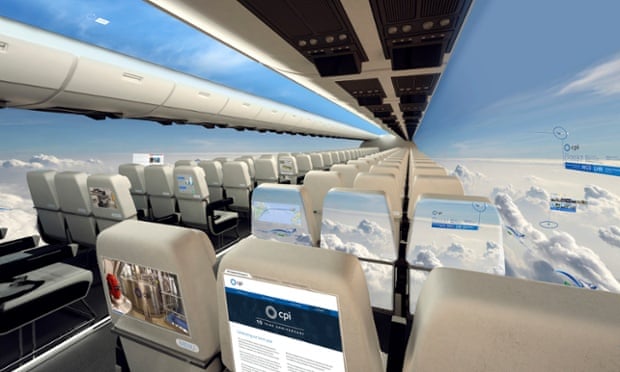
It is a glimpse into the future that will inspire wonder in some people but perhaps strike terror into the heart of the nervous flyer: a windowless plane that nonetheless allows passengers to see what’s going on outside, as well as checking their email and surfing the net.
In a vision of what the next generation of commercial aircraft could look like in little more than a decade, windows would be replaced by full-length screens allowing constant views of the world outside. Passengers would be able to switch the view on and off according to their preference, identify prominent sights by tapping the screen or even just surf the internet.
The early-stage concept for the windowless plane, based on technology used in mobile phones and televisions, hails from the Centre for Process Innovation (CPI), an organisation with sites across north-east England that works with companies to develop new products. It imagines how large, hi-definition, ultra thin and lightweight displays could form the inside of the fuselage, displaying images of the exterior from cameras mounted on the plane’s exterior.
But the real ambition echoes a constant quest in the aviation industry: how to reduce weight, which would cut fuel consumption, thereby bringing down fares. According to the CPI, for every 1% reduction in the weight of an aircraft, there is a saving in fuel of 0.75%.
The idea came about after discussions about how printable electronics, in which the centre specialises, could be used. “We had been speaking to people in aerospace and we understood that there was this need to take weight out of aircraft,” said Dr Jon Helliwell of the CPI. By putting windows into a plane, the fuselage needed to be strengthened, he added, and by omitting them in favour of walls of screens on panels, the fuselage would be lighter.
“Follow the logical thought through. Let’s take all the windows out – that’s what they do in cargo aircraft – what are the passengers going to do? If you think about it, it’s only really the people that are sitting next to windows that will suffer.”
These futuristic plans would involve screen panels reflecting whatever view of the outside the passenger wanted, changing in accordance with the direction of their eyes.
The screens would be made using organic light-emitting diodes (OLEDs) – a combination of materials that give out their own light when activated by electricity. The problems with the technology involve price and their sensitivity to moisture, which means they are generally encased in inflexible glass, mostly in mobile phones and televisions. The key development, said Helliwell, would be flexible OLEDs, which would allow the creation of screens suitable for an aeroplane. Electronics company LG recently posted a video of an 18-inch (46cm) screen which bends and contorts while the images on screen are broadcast uninterrupted.
“What would be great would be to make devices based on OLEDs that are flexible. We can make transistors that are flexible but if we can make OLEDs that are flexible, that gives us a lot of potential in the market because we can print OLEDs on to packaging, we can create flexible displays,” he said.
The CPI is one of seven bodies under the High Value Manufacturing Catapult, an umbrella group which receives government funding to drive growth in manufacturing. Part of the way the CPI operates is to identify challenges in industry – such as the windowless plane – and develop ways to overcome them, according to Helliwell.
Using £35m worth of advanced equipment in its Sedgefield facility, the CPI says it working on technologies to advance flexible OLEDs and tackle problems of cost and durability.
This could lead to the development of the OLEDs and the windowless plane, but could also be used in “smart packaging” for medicines or food which would contain information that could be displayed on a mobile phone.
One of the first steps in developing OLEDs is a mask which helps treat eye disease among people with diabetes. The device from PolyPhotonix, which was developed at the CPI, aims to stop the breakdown of blood vessels during sleep as a result of the disease. Using the device, the eye is fooled into thinking that it is daytime, when there is not the same problem with blood vessel breakdown.
The concept for the plane, said Helliwell – letting passengers see outside while allowing a lighter fuselage – followed discussions with the aerospace industry. The idea of having the displays lining the inside of the plane could become reality in 10 years, after other “building blocks” in the development of OLED are completed, he added. “We are talking about it now because it matches the kind of development timelines that they have in the aerospace industry.
“So you could have a display next to a seat if you wanted it; you could have a blank area next to a seat if you wanted it; you would have complete flexibility as to where you put [the panel screens]. You could put screens on the back of the seats in the middle and link them to the same cameras.”
What are OLEDs
OLEDs are a combination of advanced materials that give out their own light when activated by electricity and are typically used to make screens and lighting. Unlike LCD and plasma displays, they do not need a backlight, meaning that they use less energy and can be much thinner than other displays, while also displaying a higher contrast. Among ambitions for OLEDs involve printing them on sheets or wallpapering them on rooms, effectively turning the walls into lights.
Комментариев нет:
Отправить комментарий